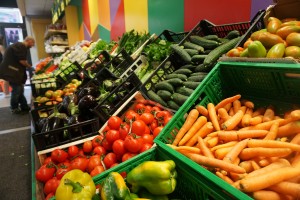On Monday June 6th, we stopped at a small historical town of Bolgheri shortly after our olive oil tasting. I had lunch at a small and cozy restaurant at the corner of Bolgheri town. The restaurant is owned by married couple and hey offer mainly slow-cooked food, like the one I’ve ordered, cut of beef reduced in red wine sauce and balsamic vinegar.
Having read Telfer’s article on food and art, which claims that food can hardly trigger emotions like a piece of art does, I was eager to prove Telfer wrong by tasting some stOn Monday June 6th, we stopped at a small historical town of Bolgheri shortly after our olive oil tasting. I had lunch at a small and cozy restaurant at the corner of Bolgheri town. The restaurant is owned by married couple and hey offer mainly slow-cooked food, like the one I’ve ordered, cut of beef reduced in red wine sauce and balsamic vinegar.
unning dishes that could move my heart, mind and emotions like nothing else does.
The restaurant at Bolgheri uses a casserole dish to sear the beef brisket first, then puts on a simmer with a variety of locally grown seasonal vegetables such as carrots and fennels. The long simmering process allows the beef to take on multiple flavors from the vegetables. Reducing in red wine and basaltic vinegar also gives the sauce a spicy kick, stimulating our taste buds do we could continue eating this rich dish without feeling overly greasy.
Nowadays, to achieve the best flavor, chefs usually utilize technologies such as a pressure cooker or even a sous vide to allow maximum flavor penetration and perfect donees. Yet, in my opinion, traditional simmering with a casserole or a terracotta pot magnifies the effort put in by the chef. Every dish cooked in this way is authentic. It is a not a result of following a fixed formula and let machines take over. Slow cooking requires continuous effort in observing the texture and state of the food and adjusting it correspondingly. It also eliminates the use of technology such as sous vide, whic h is gradually making cooking an industrial process even on a small level.
h is gradually making cooking an industrial process even on a small level.
I’m glad that in such competitive European culinary field, there are still people like this couple who uses the most traditional method to cook such dish. They are, in some ways, not aiming at maximizing their profits, but upholding the art of cooking, which many high-end restaurants no longer practice. To me, the plate of beef brisket may neither have the best color, nor the best plating. But they do have the best effort from the chefs, and personally, a taste and structure beyond my level of expectation.
This dinning experience also reminds me of my visit to Chihuly glass museum in Seattle Washington. The glass structures are surely beautiful, but what captured my heart was seeing the process of glass making, a true process of artisanship. Similar to this, I believe that a dish can be regarded as art only if a mindful and effortful process is put behind in making it. And I believe that traditional way of cooking is such a process. Hence, I have to disagree with Telfer, and say that food can indeed move us just like a piece of art does. The food itself may not have to be aesthetically beautiful be general standards, but the traditional process of making it is definitely art, w
ithout any doubt.
